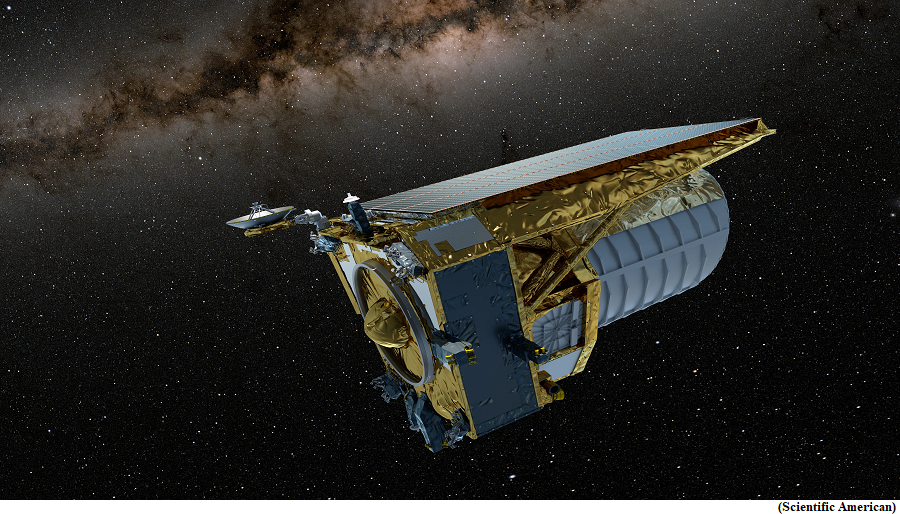Euclid space telescope (GS Paper 3, Science and Technology)

Why in news?
- Recently, Euclid Space Telescope commenced its mission to observe the dark universe.
- Launched on board a SpaceX Falcon-9 rocket, the telescope, led by the European Space Agency, embarked on a trajectory that will take it to a destination approximately 1.5 million kilometers away from Earth, known as the second Lagrange point (L2).
Details:
- It is named after the Greek mathematician who resided in Egypt’s Alexandria.
- Euclid's objective is to create the most precise 3D map of the universe by observing billions of galaxies spread across more than 10 billion light-years, encompassing over a third of the sky, during its six-year-long mission.
- This comprehensive map has the potential to unveil the expansion of the universe and the evolution of its large-scale structure throughout cosmic history.
What is dark universe?
- It is composed of two main components: dark matter and dark energy. While dark matter makes up about 85% of the matter in the universe, dark energy makes up about 70% of the energy in the universe.
- It is in fact, dark matter that holds galaxies together and prevents them from flying apart.
- Without dark matter, galaxies would not be able to form. Meanwhile, dark energy causes the universe to expand at an accelerating rate.
- Euclid’s precise measurements of cosmic structure could uncover the total mass of neutrinos in our Universe, and with this how much of dark matter they can make up.
What is Euclid Space Telescope?
- Euclid is designed to observe the large-scale structure of the universe and create a 3D map to reveal how the universe has expanded and how large-scale structure has evolved over cosmic history.
- The spacecraft will provide imagery, visible, spectroscopy and photometry data in the near-infrared spectrum of light that cannot be seen with the eyes.
- The nearly 2-tonne spacecraft is equipped with a 1.2-meter diameter primary mirror, a Near Infrared Spectrometer and Photometer.
- A sunshield will keep the telescopes and instruments shaded from the Sun to ensure thermal stability and highly sensitive measurements as the VISible instrument (VIS) will have to operate at -120 degrees Celsius and the Near Infrared Spectrometer and Photometer (NISP) at -180 degrees Celsius.
Way Forward:
- Scientists hope to better understand the role of gravity and the nature of dark energy and dark matter with the new flying observatory.
Bihar govt asks GSI for detailed exploration for gold reserves in Jamui
(GS Paper 3, Economy)
Why in news?
- Bihar’s Department of Mines and Geology has asked the Geological Survey of India to carry out a detailed exploration to trace gold reserves in Sono area of Jamui district, after the state government decided to allow auction of nine mineral blocks.
- The department has also asked the ASI to extend the exploration work to identify more coal-bearing areas in Batesarthan-Kasri-Jagarnathpur area in Bhagalpur district.

Four stages of exploration:
- There are four stages of exploration for mineral deposits - reconnaissance survey (G4), preliminary exploration (G3), general exploration (G2) and detailed exploration (G1).
- Geophysical work has to be completed before taking up drilling and exploration for the presence of gold reserves in Sono. The G4 stage exploration (preliminary survey) is required to find out the presence of any gold reserve in the area.
Coal blocks:
- Earlier, the GSI carried out G3 exploration for fireclay in Batesarthan-Kasri-Jagarnathpur area, and reported presence of carbonaceous shale with patches of coal at a depth of around 47-68 metre. Presence of coal was not reported in this part earlier.
- The area is in the north of Mandar Parvat block, where the Central Mine Planning and Design Institute (CMPDI) has established reserves of coal.
- The DMG has now asked the ASI to extend the exploration work further to identify more coal-bearing areas in the Bhagalpur region.
Auction:
- The Bihar government had recently engaged SBI Capital Markets Ltd as transaction advisor, and state-run Metal Scrap Trading Company (MSTC) for providing the platform for auction of the nine mineral blocks in different parts of the state.
- The nine mineral blocks ready for auction include 48.40 million tonne of magnetite in non-forest areas of Majos (Jamui), 88.38 MT of glauconite in 12.46 sq km non-forest areas in Pipradih-Bhurwa and Chutia-Nauhatta in Rohtas.



